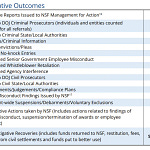I go over how life/annuity insurers go insolvent, and why we’ve not seen any big insolvencies in the United States lately… (let’s not jinx this). Some history of insurance regulation and life insurer insolvencies. Insurers aren’t banks, you know.

Episode Links
December 2012: “A Tale of Two Formulas: Solvency II SCR and RBC”
An article I wrote for the Society of Actuaries newsletter, The Financial Reporter, to contrast a specific item of European and United States solvency regulation.
To begin with, there is a top-down vision of the Solvency II SCR: It is defined as being the one-year value at risk (VaR) at the 99.5 percent confidence level. One starts at this high-level concept and then drills down to modules and submodules of risk that conform to this vision.
….
On the other hand, U.S. RBC is more of a bottom-up calculation in its core concept. There is no specific time horizon or risk metric that is specified, much less a specified confidence level. As the RBC formula has been updated, it has been at the component level, with various pieces having their own calibration points, not necessarily in conjunction with any other factors seen in the equation. The method for updating RBC has been one of incrementalism, with new factors being targeted to very specific risks and/or lines of business.
Record of the Atlanta Spring 1999 Meeting of the Society of Actuaries: Insurance Company Failures of the Early 1990s-Have We Learned Anything?
Summary: The early 1990s saw the failure of three major life insurance companies in North America-Executive Life, Mutual Benefit, and Confederation Life.
The panel looks back at the settlements of these insolvencies and how different policyholders fared. Changes in the insurance industry, credit analysis, and marketplace resulting from these failures are discussed. The panel also represents the changes in regulation designed to prevent or lessen the impact of future insolvencies and tries to assess the likelihood of a major failure in the future.
Guaranty Funds
National Organization of Life and Health Insurance Guaranty Associations
The National Organization of Life and Health Insurance Guaranty Associations (NOLHGA) is a voluntary association made up of the life and health insurance guaranty associations of all 50 states and the District of Columbia.
NOLHGA was founded in 1983 when the state guaranty associations determined that there was a need for a mechanism to help them coordinate their efforts to provide protection to policyholders when a life or health insurance company insolvency affects people in many states.
The National Conference of Insurance Guaranty Funds
At the heart of every property and casualty insurance contract lies a promise that if misfortune occurs, insurance will step in to soften the blow by covering outstanding claims.
But what happens when an insurance company becomes financially troubled, fails and is no longer able to uphold its end of the bargain?
That’s when the state property and casualty guaranty fund system – a system few know much about – steps in. Put simply, guaranty funds provide an essential safety net for policyholders, one that meets the needs of those least able to deal with losses should their insurance company fail.
The National Conference of Insurance Guaranty Funds (NCIGF) – a non-profit, member-funded association – provides national assistance and support to the property and casualty guaranty funds located in each of the 50 states, the District of Columbia, and the Commonwealth of Puerto Rico.
Wikipedia Links:
National Organization of Life and Health Insurance Guaranty Associations
The National Organization of Life and Health Insurance Guaranty Associations[1] (often abbreviated NOLHGA) is a voluntary, U.S. association made up of the life and health insurance guaranty associations of all 50 states and the District of Columbia. NOLHGA was founded in 1983 to coordinate the efforts of state guaranty associations to provide protection to policyholders when their multi-state life or health insurance company becomes insolvent.[2]
….
When an insurance company reports to its state insurance regulator that it is in financial trouble, the state will first attempt to assist the company back toward financial stability. If the state insurance department determines the company cannot be saved, then the insurance commissioner asks the state court to order the liquidation of the company.[3] Once the order to liquidate a company that operates in multiple states is handed down, NOLHGA, on behalf of affected member state guaranty associations, assembles a task force of affected guaranty associations to analyze the company’s commitments to policyholders. Each affected state guaranty association pays out claims to the insurance company's policyholders in the state; in some instances, the associations arrange for policies to be transferred to a financially sound insurer.[2] Each state guaranty association is governed by state law; most associations cover up to at least $300,000 for life insurance death benefits, $100,000 in cash surrender value for life insurance, $250,000 in withdrawal and cash values for annuities, and up to $500,000 in health insurance policy benefits (depending on the type of health insurance in question).[4][5]
Executive Life
Executive Life Insurance Company (ELIC) was once the largest life insurance company in California. Its financial problems and subsequent insolvency in April 1991 shocked its policyholders and the financial world.[1]
At the time, First Executive was the biggest insurer ever to fail, which resulted primarily from money-losing investments in junk bonds.
….
In 2003, Crédit Lyonnais and others agreed to pay $771 million in settlements resulting from false statements to bank regulators in connection with the acquisition of junk bonds and the insurance business of the failed Executive Life Insurance Company of California.[5]
….
A subsidiary, Executive Life Insurance Company of New York (ELNY), was seized by the state of New York, who sold the majority of the business to MetLife, retaining the structured settlement book of business. Due to mismanagement, ELNY was ordered to liquidate.[9] Guaranty Association Benefits Company took over the assets of ELNY in 2013.
Mutual Benefit Life Insurance Company
Mutual Benefit Life was taken into receivership for rehabilitation by the New Jersey Department of Banking and Insurance on July 16, 1991, after losses in an overheated real estate market led to a run by policyholders, who ultimately lost the purported "cash value" that had been said to have accrued in their policies. At the time, the collapse was the largest ever of an American insurer. AMEV acquired the group life, accident and health insurance Mutual Benefit in 1991.[5] SunAmerica acquired the remaining divisions in 1998.[6] Effective June 14, 2001, Mutual Benefit was liquidated and dissolved.[7]












Share this post